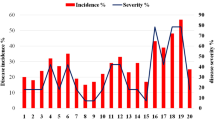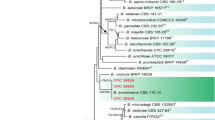Abstract
In 2017, premature abscission of leaves and dry rot with discoloration on the epidermis of the stem were observed in the field of reproductive-stage soybean in southern Shan State and the Nay Pyi Taw region in Myanmar. On the basis of morphological characteristics, two fungal genera, Colletotrichum and Diaporthe, were identified. Multilocus phylogenetic analyses based on the ITS, TUB and EF1-α genes for Diaporthe and the ITS, ACT, GAPDH, and CHS-1 genes for Colletotrichum were used to identify the species as Colletotrichum plurivorum, C. truncatum, Diaporthe endophytica and D. melonis. The pathogenicity of the collected isolates was confirmed by inoculation of soybean cultivar (Yezin-10), and all species except for C. plurivorum were virulent. The isolates of C. plurivorum were less aggressive than the other isolates. Koch’s postulate was fulfilled by reisolation of the original inoculated fungal isolates from the symptomatic tissue. In two locations in Myanmar, C. plurivorum, D. endophytica and D. melonis occurred in southern Shan State, whereas only one C. truncatum was found in the Nay Pyi Taw region. This is the first report of Colletotrichum and Diaporthe species associated with soybean stem diseases in Myanmar.





Similar content being viewed by others
References
Ash GJ, Stodart B, Sakuanrungsirikul S, Anschaw E, Crump N, Hailstones D, Harper JDI (2010) Genetic characterization of a novel Phomopsis sp., a putative biocontrol agent for Carthamus lanatus. Mycologia 102:54–61
Bailey JA, Jeger MJ (eds) (1992) Colletotrichum: biology, pathology and control. CABI, Wallingford
Barbieri MCG, Ciampi-Guillardi M, Moraes SRG, Bonaldo SM, Rogerio F, Linhares RR, Massola NS (2017) First report of Colletotrichum cliviae causing anthracnose on soybean in Brazil. Plant Dis 101:1677
CAB International (2001) Colletotrichum truncatum [distribution map]. In: Distribution maps of plant diseases 1st edn, map no. 835. https://www.cabi.org/ISC/abstract/20066500835. CABI, Wallingford, UK.
Carbone I, Kohn LM (1999) A method for designing primer sets for speciation studies in filamentous ascomycetes. Mycologia 91:553–556
Chen LS, Chu C, Liu CD, Chen RS, Tsay JG (2006) PCR-based detection and differentiation of anthracnose pathogens, Colletotrichum gloeosporioides and C. truncatum, from vegetable soybean in Taiwan. J Phytopathol 154:654–662
CSO (2017) 2017 Myanmar statistical yearbook. Central Statistical Organization, Ministry of National Planning and Economics Development, Nay Pyi Taw
Damm U, Sato T, Alizadeh A, Groenewald JZ, Crous PW (2019) The Colletotrichum dracaenophilum, C. magnum and C. orchidacearum species complexes. Stud Mycol 92:1–46
Damm U, Woudenberg JHC, Cannon PF, Crous PW (2009) Colletotrichum species with curved conidia from herbaceous hosts. Fungal Divers 39:45–87
Dissanayake AJ, Phillips AJL, Hyde KD, Yan JY, Li XH (2017) The current status of species in Diaporthe. Mycosphere 8:1106–1156
Fu M, Crous PW, Bai Q, Zhang PF, Xaing J, Guo YS, Zhao FF, Yang MM, Hong N, Xu WX, Wang GP (2018) Colletotrichum species associated with anthracnose of Pyrus spp. in China. Persoonia 42:1–35
Gardes M, Bruns TD (1993) ITS primers with enhanced specificity for basidiomycetes-application to the identification of mycorrhizae and rust. Mol Ecol 2:113–118
Glass LN, Donaldson GC (1995) Development of primer sets designed for use with the PCR to amplify conserved genes from filamentous ascomycetes. Appl Environ Microbiol 61:1323–1330
Gomes RR, Glienke C, Videira SIR, Lombard L, Groenewald JZ, Crous PW (2013) Diaporthe: a genus of endophytic, saprobic and plant pathogenic fungi. Persoonia 31:1–41
Kimura M (1980) A simple method for estimating evolutionary rates of base substitutions through comparative studies of nucleotide sequences. J Mol Evol 16:111–120
Kmetz KT, Schmitthenner AF, Ellette CW (1978) Soybean seed decay: prevalence of infection and symptom expression caused by Phomopsis sp., Diaporthe phaseolorum var. sojae, and D. phaseolorum var. caulivora. Phytopathology 68:836–840
Kull LS, Vuong TD, Powers KS, Eskridge KM, Steadman JR, Hartman GL (2007) Evaluation of resistance screening methods for Sclerotinia stem rot of soybean and dry bean. Plant Dis 87:1471–1476
Kumar S, Stecher G, Tamura K (2016) MEGA7: Molecular evolutionary genetics analysis version 7.0 for bigger datasets. Mol Biol Evol 33:1870–1874
Lanfear R, Calcott B, Ho SYW, Guindon S (2012) Partitionfinder: combined selection of partitioning schemes and substitution models for phylogenetic analyses. Mol Biol Evol 29:1695–1701
Li S, Bradley CA, Hartman GL, Pedersen WL (2001) First report of Phomopsis longicolla from velvetleaf causing stem lesions on inoculated soybean and velvetleaf plants. Plant Dis 85:1031
Li S, Hartman GL, Boykin DL (2010) Aggressiveness of Phomopsis longicolla and other Phomopsis spp. on soybean. Plant Dis 94:1035–1040
Liu F, Tang G, Zheng X, Li Y, Sun X, Qi X, Zhou Y, Xu J, Chen H, Chang X, Zhang S, Gong G (2016) Molecular and phenotypic characterization of Colletotrichum species associated with anthracnose disease in peppers from Sichuan Province, China. Sci Rep 6:1–17
Manandhar JB, Hartman GL, Sinclair JB (1986) Colletotrichum destructivum, the anamorph of Glomerella glycines. Phytopathology 76:282–285
Mostert L, Crous PW, Kang J-C, Phillips AJL (2001) Species of Phomopsis and a Libertella sp. occurring on grapevines with specific reference to South Africa: morphological, cultural, molecular and pathological characterization. Mycologia 93:146–167
Nilsson RH, Kristiansson E, Ryberg M, Hallenberg N (2008) Intraspecific ITS variability in the kingdom Fungi as expressed in the international sequence databases and its implications for molecular species identification. Evol Bioinform 4:193–201
Rehner SA, Uecker FA (1994) Nuclear ribosomal internal transcribed spacer phylogeny and host diversity in the coelomycete Phomopsis. Can J Bot 72:1666–1674
Riccioni L, Conca G, Hartman GL (1998) First report of Colletotrichum coccodes on soybean in the United States. Plant Dis 82:959
Ronquist F, Teslenko M, van der Mark P et al (2012) MrBayes 3.2: efficient Bayesian phylogenetic inference and model choice across a large model space. Syst Biol 61:539–542
Sakthivel K, Manigundan K, Sneha S, Patel A, Charishma K, Neelam S, Gautam RK, Kumar A (2018) First report of Colletotrichum plurivorum from the Andaman and Nicobar Islands causing anthracnose in chilli (Capsicum annuum). New Dis Rep 38:26
Santos JM, Vrandečić K, Ćosić J, Duvnjak T, Phillip AJL (2011) Resolving the Diaporthe species occurring on soybean in Croatia. Persoonia 27:9–19
Schoch CL, Seifert KA, Huhndorf S, Robert V, Spouge JL, Levesque CA, Chen W, Consortium FB (2012) Nuclear ribosomal internal transcribed spacer (ITS) region as a universal DNA barcode marker for Fungi. Proc Natl Acad Sci 109:6241–6246
Shan Z, Li S, Liu Y, Yang Z, Yang C, Sha A, Chen H, Chen S, Zhou XA (2013) First report of Phomopsis seed decay of soybean caused by Phomopsis longicolla in South China. Plant Dis 96:1693
Shishido M, Yoshida N, Usami T, Shinozaki T, Kobayashi M, Takeuchi T (2006) Black root rot of cucurbits caused by Phomopsis sclerotioides in Japan and phylogenetic grouping of the pathogen. J Gen Plant Pathol 72:220–227
Singh R, Singh SB, Singh PN (2001) Effect of environmental conditions on development of anthracnose of soybean. Ann Plant Protein Sci 9:146–147
Sun YC, Damm U, Huang CJ (2019) Colletotrichum plurivorum, the causal agent of anthracnose fruit rot of papaya in Taiwan. Plant Dis 11:1040
TeKrony D, Egli D, Stuckey R (1983) Relationship between weather and soybean seed infection by Phomopsis sp. Phytopathology 73:914–918
Templeton MD, Rikkerink EHA, Solon SL, Crowhurst RN (1992) Cloning and molecular characterization of the glyceraldehyde-3-phosphate dehydrogenase-encoding gene and cDNA from the plant pathogenic fungus Glomerella cingulata. Gene 122:225–230
Thaung MM (2008) Biodiversity survey of coelomycetes in Burma. Australas Mycol 27:74–110
Thompson JD, Higgins DG, Gibson TJ (1994) ClustalW: improving the sensitivity of progressive multiple sequence alignment through sequence weighting, position specific gap penalties and weight matrix choice. Nucleic Acids Res 22:4673–4680
Twizeyimana M, Hill CB, Pawlowski M, Paul C, Hartman GL (2012) A cut-stem inoculation technique to evaluate soybean for resistance to Macrophomina phaseolina. Plant Dis 96:1210–1215
Udayanga D, Castlebury LA, Rossman AY, Chukeatirote E, Hyde KD (2015) The Diaporthe sojae species complex: phylogenetic re-assessment of pathogens associated with soybean, cucurbits and other field crops. Fungal Biol 119:383–407
Udayanga D, Castlebury LA, Rossman AY, Hyde KD (2014) Species limits in Diaporthe: molecular re-assessment of D. citri, D. cytosporellaD. foeniculina and D. rudis. Persoonia 32:83–101
USDA (2018) World agricultural production: crop production tables. Production, Supply and Distribution, Office of Global Analysis, Foreign Agricultural Service/USDA, Washington.
Weir BS, Johnston PR, Damm U (2012) The Colletotrichum gloeosporioides species complex. Stud Mycol 73:115–180
White TJ, Bruns T, Lee S, Taylor JW (1990) Amplification and direct sequencing of fungal ribosomal RNA genes for phylogenetics. In: Innis MA, Gelfand DH, Sninsky JJ, White TJ (eds) PCR protocols: a guide to methods and amplification. Academic Press, San Diego, pp 315–322
Wrather JA, Anderson TR, Arsyad DM, Gai J, Ploper LD, Porta Puglia A, Ram HH, Yorinori JT (1997) Soybean disease loss estimates for the top 10 soybean producing countries in 1994. Plant Dis 81:107–110
Wrather JA, Shannon G, Balardin R, Carregal L, Escobar R, Gupta GK, Ma Z, Morel W, Ploper D, Tenuta A (2010) Effect of diseases on soybean yield in the top eight producing countries in 2006. Plant Health Prog. https://doi.org/10.1094/PHP-2010-0125-01-RS
Yang H-C, Haudenshield JS, Hartman GL (2014) Colletotrichum incanum sp. nov., a curved-conidial species causing soybean anthracnose in USA. Mycologia 106:32–42
Zhang AW, Riccioni L, Pedersen WL, Kollipara KP, Hartman GL (1998) Molecular identification and phylogenetic grouping of Diaporthe phaseolorum and Phomopsis longicolla isolates from soybean. Phytopathology 88:1306–1314
Acknowledgements
This research was supported by the Japanese Government (Monbukagakusho: MEXT) scholarship programme and a Grand-in-Aid for Scientific Research (no. 18K05652) from the Japan Society for the Promotion of Science. We thank Mr. Thet Tun Aung, Programme officer, and Mr. Aye Kyaw, Soybean/oil Seed Programme Officer, Value Chains and Rural Development, Taunggyi Field Office, Winrock International, Myanmar for their support during field sample collection.
Author information
Authors and Affiliations
Corresponding author
Ethics declarations
Conflict of interest
The authors have no conflicts of interest to declare.
Ethical approval
This article does not contain any studies with human participants or animals performed by any of the authors.
Additional information
Publisher's Note
Springer Nature remains neutral with regard to jurisdictional claims in published maps and institutional affiliations.
Rights and permissions
About this article
Cite this article
Zaw, M., Aye, S.S. & Matsumoto, M. Colletotrichum and Diaporthe species associated with soybean stem diseases in Myanmar. J Gen Plant Pathol 86, 114–123 (2020). https://doi.org/10.1007/s10327-019-00902-5
Received:
Accepted:
Published:
Issue Date:
DOI: https://doi.org/10.1007/s10327-019-00902-5




